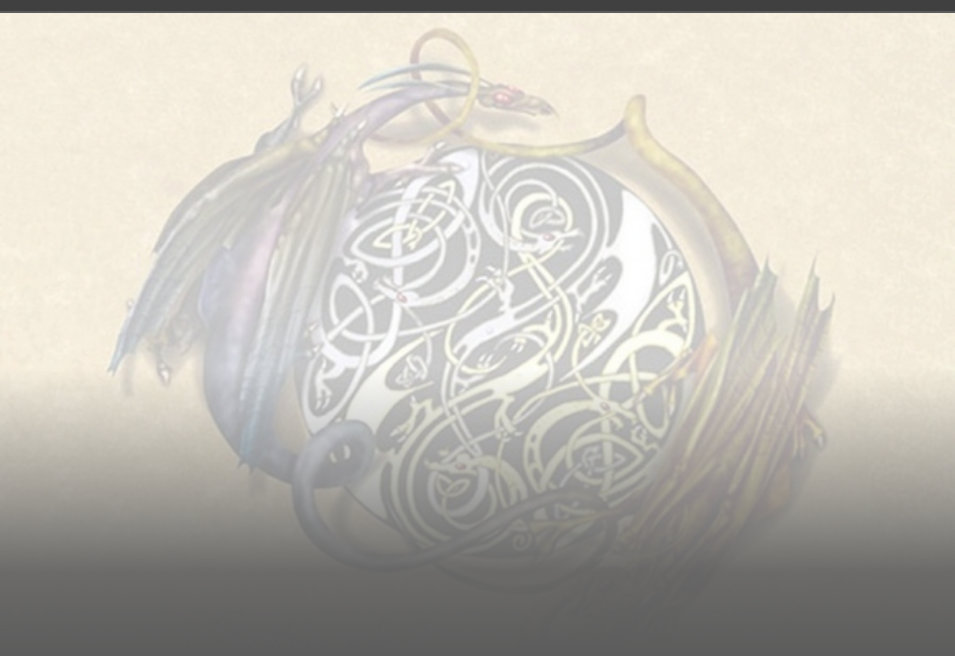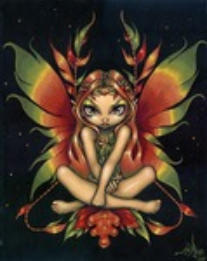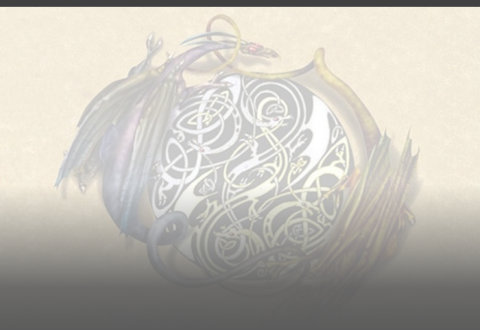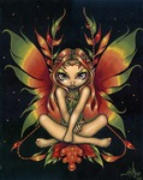

Crystal’s Place
my little piece of the web


© Crystal (aka Dragonfae) 2010-2024
A Little Halloween History
Some history on one of my favorite holidays
The origins of Halloween as we know it today are, ironically, mostly Christian. I find this to be hysterically funny since some of the more fundamentalist Christians are the most vocal against this (now secular) holiday. The roots of this holiday begin with Samhain (pronounced sow-an), a harvest festival marking the end of the Celtic year and summer. After the last harvest of the year, and after the livestock were brought in from the fields to be wintered close to home (and probably in barns in the colder regions), the Celtic peoples celebrated around huge bonfires. The bonfires were sacred (sometimes tended by the Druids) and at the end of the evening each family would take wood from the bonfire to light the fires in their homes in the hope of bringing warmth and good fortune during the long dark nights of winter. It’s believed by many (myself included) that the veil between our world and those surrounding us (some refer to it as the spirit world, though I think there are many of these “worlds”) is thinner at this time of year, and during the Samhain celebration some wore costumes, perhaps as a means to either communicate with or frighten off spirits that might be present. Early in the first century, after the Romans invaded the Celtic lands, some of their traditions began to creep into the yearly Samhain celebration. During Feralia (a day in late October commemorating the passing of the dead) the Romans would pour milk on the graves of their ancestors and leave little cakes to keep them from rising and haunting their relatives. Around this time of year the Romans also held celebrations honoring Pomona, the Roman goddess of fruit and trees (her symbol is the apple) which may be where the current tradition of bobbing for apples comes from. In 609 AD Pope Boniface IV declared May 13th to be “All Martyrs Day” and dedicated the Pantheon in Rome to all Christian Martyrs. In the early 700’s Pope Gregory III declared that all Saints should also be included, renamed the day “All Saints Day” (Alholowmesse in Middle English), and moved the holiday to November 1st in order to incorporate/co-opt the pagan holidays (it’s easier to convert the populace if they can keep customs they’re comfortable with), though it took some time (about 200 years) to accomplish this. Around 1000 AD, the Church added All Souls Day on November 2nd to further the dilution of the Celtic/Roman holidays. The three days, Samhain, All Saints Day, and All Souls Day began to be known simply as All Hallowmas with Samhain now being called All Hallows Evening … which was eventually shortened to Hallows Even or Eve. Much later, it was further shortened to Halloween. The practice of trick-or-treat may have begun with youths going door to door offer to pray for the souls of the occupants’ passed relatives in exchange for small cakes. The Church told its followers that enough prayers needed to be offered up to guarantee a passed soul’s passage into Heaven or they might get stuck in Purgatory. The Church encouraged the passing out of “soul cakes” to the poor as a way of discouraging the leaving of cakes and wine or milk for roaming spirits who might be traveling the roads on Samhain. The association of bats with Halloween may come from the bonfires the ancient Celts lit for their Samhain festival … insects are drawn to the heat and light of a fire and bats may have been attracted as well to feed on the insects. And of course, witches and cats have a long history of being feared (and not just on Halloween). I’m not sure when the practice of holding a “Dumb Supper” started but this practice is still used by some pagans to honor their ancestors during this time of year since the chance of a visit is more likely with the thinned veil. (a Dumb Supper is a meal where a place is set for one or more ancestors who’ve passed so they may join the meal in spirit … the entire meal is set and eaten in complete silence) The tradition of the Jack O’Lantern has roots in an old Irish myth about a man called “Stingy Jack” who is said to have tricked the Devil out of claiming his soul when he died and was condemned to walk the Earth since he was too “unsavory” to get into Heaven. It’s said that he’d wander the Earth at night with a hot coal inside a turnip (used as a lantern) to light his way. Irish folk used to carve faces into turnips and light them from within using candles to make their own lanterns, but with a scary face to ward off “Stingy Jack” if he came around. Immigrants to the US found that pumpkins made a better “canvas” for these carvings than turnips did … they’re also a lot easier to carve so I’m sure that was a factor too. By the early 1900’s Halloween was a completely secular holiday focused around the community, games, food, and costumes and eventually morphed into the holiday we all know and love today. It’s definitely one of my favorite holidays (topped only by Yule/Christmas). For me, knowing some of the history behind the traditions I observe makes the holiday more interesting.


Crystal’s Place
my little piece of the web


© Crystal (aka Dragonfae) 2010-2024
A Little
Halloween
History
Some history on one of my
favorite holidays
The origins of Halloween as we know it today are, ironically, mostly Christian. I find this to be hysterically funny since some of the more fundamentalist Christians are the most vocal against this (now secular) holiday. The roots of this holiday begin with Samhain (pronounced sow-an), a harvest festival marking the end of the Celtic year and summer. After the last harvest of the year, and after the livestock were brought in from the fields to be wintered close to home (and probably in barns in the colder regions), the Celtic peoples celebrated around huge bonfires. The bonfires were sacred (sometimes tended by the Druids) and at the end of the evening each family would take wood from the bonfire to light the fires in their homes in the hope of bringing warmth and good fortune during the long dark nights of winter. It’s believed by many (myself included) that the veil between our world and those surrounding us (some refer to it as the spirit world, though I think there are many of these “worlds”) is thinner at this time of year, and during the Samhain celebration some wore costumes, perhaps as a means to either communicate with or frighten off spirits that might be present. Early in the first century, after the Romans invaded the Celtic lands, some of their traditions began to creep into the yearly Samhain celebration. During Feralia (a day in late October commemorating the passing of the dead) the Romans would pour milk on the graves of their ancestors and leave little cakes to keep them from rising and haunting their relatives. Around this time of year the Romans also held celebrations honoring Pomona, the Roman goddess of fruit and trees (her symbol is the apple) which may be where the current tradition of bobbing for apples comes from. In 609 AD Pope Boniface IV declared May 13th to be “All Martyrs Day” and dedicated the Pantheon in Rome to all Christian Martyrs. In the early 700’s Pope Gregory III declared that all Saints should also be included, renamed the day “All Saints Day” (Alholowmesse in Middle English), and moved the holiday to November 1st in order to incorporate/co- opt the pagan holidays (it’s easier to convert the populace if they can keep customs they’re comfortable with), though it took some time (about 200 years) to accomplish this. Around 1000 AD, the Church added All Souls Day on November 2nd to further the dilution of the Celtic/Roman holidays. The three days, Samhain, All Saints Day, and All Souls Day began to be known simply as All Hallowmas with Samhain now being called All Hallows Evening … which was eventually shortened to Hallows Even or Eve. Much later, it was further shortened to Halloween. The practice of trick-or-treat may have begun with youths going door to door offer to pray for the souls of the occupants’ passed relatives in exchange for small cakes. The Church told its followers that enough prayers needed to be offered up to guarantee a passed soul’s passage into Heaven or they might get stuck in Purgatory. The Church encouraged the passing out of “soul cakes” to the poor as a way of discouraging the leaving of cakes and wine or milk for roaming spirits who might be traveling the roads on Samhain. The association of bats with Halloween may come from the bonfires the ancient Celts lit for their Samhain festival … insects are drawn to the heat and light of a fire and bats may have been attracted as well to feed on the insects. And of course, witches and cats have a long history of being feared (and not just on Halloween). I’m not sure when the practice of holding a “Dumb Supper” started but this practice is still used by some pagans to honor their ancestors during this time of year since the chance of a visit is more likely with the thinned veil. (a Dumb Supper is a meal where a place is set for one or more ancestors who’ve passed so they may join the meal in spirit … the entire meal is set and eaten in complete silence) The tradition of the Jack O’Lantern has roots in an old Irish myth about a man called “Stingy Jack” who is said to have tricked the Devil out of claiming his soul when he died and was condemned to walk the Earth since he was too “unsavory” to get into Heaven. It’s said that he’d wander the Earth at night with a hot coal inside a turnip (used as a lantern) to light his way. Irish folk used to carve faces into turnips and light them from within using candles to make their own lanterns, but with a scary face to ward off “Stingy Jack” if he came around. Immigrants to the US found that pumpkins made a better “canvas” for these carvings than turnips did … they’re also a lot easier to carve so I’m sure that was a factor too. By the early 1900’s Halloween was a completely secular holiday focused around the community, games, food, and costumes and eventually morphed into the holiday we all know and love today. It’s definitely one of my favorite holidays (topped only by Yule/Christmas). For me, knowing some of the history behind the traditions I observe makes the holiday more interesting.



































